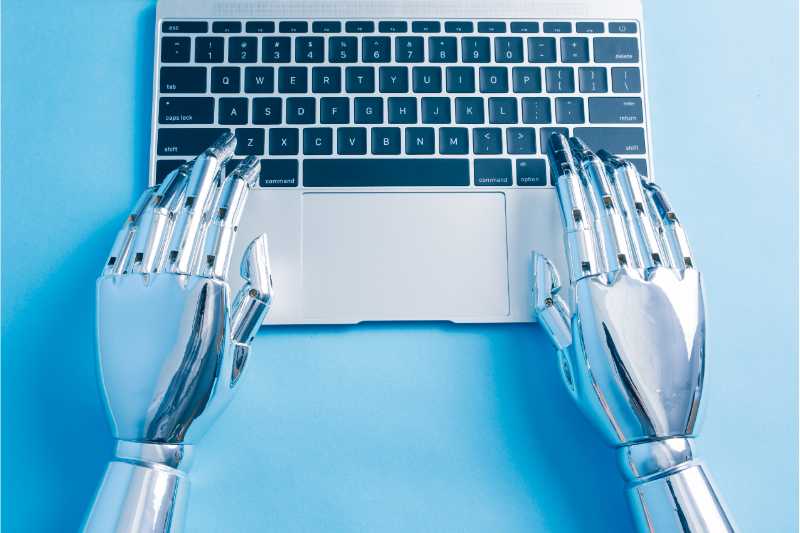Extract Data from Invoice – A Simple Way to Do It

Using Artificial Intelligence and technologies like Optical Character Recognition is the easiest and fastest way to extract information from PDFs and images. Extracting information with AI is so common that you may have used this technology without realizing it.
A lot of banks and fintech companies use OCR technology to speed up the signup process for clients. For instance, banking apps often ask you to take a photo of your identification card. Apps use extracted data from your ID to fill out specific fields automatically. You have to review information and edit fields when needed, but it reduces the time spent signing up for an account.
Invoice data extraction follows the same process but instead of personal data, it captures information such as the invoice date, invoice number, amount, items purchased, and other invoice details.
Why Automate Data Entry Now
Taking information from an invoice and entering it into accounting software is simple enough that anyone can do it. However, as transaction volumes increase, a manual data entry to process invoices takes a toll on the AP staff.
Imagine this scenario.

An organization receives 500 invoices a month. If the average employee can process five invoices in an hour, an employee should complete invoice processing for 25 invoices in a day if there are 20 working days a month. Using the same assumption, an employee needs about 5 hours to enter information.
What if the invoices received by the company increase to a thousand?
Why AP Teams Struggle With Invoices
AP teams have to work extra hours to input data into the company software. Since data entry is Step 1 in the process, delays in data processing can create a ripple effect on the invoice processing cycle.
Unless the company adds another employee, it’s difficult to keep up with the workload. An Institute of Finance and Management survey reveals that 50% of AP staff compensate for the increasing volume of invoices by working longer hours.[1]
In some companies, only one employee handles processing about a hundred invoices a day. Employees often have extra responsibilities such as contacting vendors, requesting proof of delivery, and solving issues in the AP department on top of invoice processing. It’s not unusual for an AP staff to work over 60 hours a week!
As the workload increases for AP, employees almost always fall behind.
And this is why AP employees have a never-ending to-do list. Scrambling to keep up when the month-end comes around is an issue most companies deal with. What’s worse is that data entry nightmares don’t end with AP.
After invoices get approved, accounting departments must prepare cash disbursements. If your company maintains multiple systems that require invoice data, you need to enter information several times.

In small organizations with a few invoices to process, manual data processing may be the least of their problems, but it’s a different story for companies with high invoice volumes.
Unsurprisingly, about half of AP staff have plans of leaving their current organization. Reasons cited include getting burned out or retirement.
About a quarter of companies intend to use automation to make working conditions bearable. But how does automated data extraction reduce the burden for AP and accounting teams?
Smart Invoice OCR – A Quick Overview
Smart technologies use OCR and Machine Learning (ML) to extract information from scanned copies of receipts.
Extracting data from invoices may not be the most glamorous application of artificial intelligence, but it brings significant changes to business operations.
Companies can reduce hours spent on processing invoices by 30 to 40% – even with the most rudimentary AI techniques. [2]
Today, most expense management solutions are accessible through a website and a smartphone app.
Envoice, for instance, allows users to upload PDFs or images containing invoice data through the website or send the attachment to a dedicated email address. Meanwhile, app users can take a photo of the receipt with the app.
Technologies like automated invoice processing use AI to learn from human experience but it’s ultimately up to the user to make decisions.
Bots read information from an invoice line item and identify data automatically even if invoice layouts vary from one supplier to another. However, companies can still add human review to achieve even higher accuracy rates.
OCR technologies also have an advantage over manual invoice processing since AI can handle receipts in multiple languages. Even if a receipt is not in a language you’re familiar with, you can still map information to the correct field.
Reducing time spent entering data or translating information from a foreign invoice frees up significant time for accounting and AP teams. More importantly, it solves some of the biggest pain points in a manual AP environment.
How Does Manual Data Processing Hurt Your Business?
Entering invoices manually creates various problems for businesses. Here are some examples.

High error rates
Manual data entry is prone to errors. A survey finds that 47% of organizations encountered data entry errors for non-payroll expenses. Executives who participated in the study consider data entry mistakes as the most important challenge for their firm.
Data entry mistakes can lead to problems like paying the incorrect vendor, issuing a check that is higher or lower than the invoice amount, and issuing duplicate payments. Fixing a mistake and identifying the cause can be time-consuming, especially for AP who already have too much on their plate.
Higher Compliance Costs
Human errors increase inaccuracies in the information entered manually. Companies compensate by putting internal controls such as requiring employees to review invoices one by one to validate costs and ensure that information like invoice amount and payee are correct.
To compensate for higher risk, companies spend money to perform transactional activities and make sure they’re correct. Accounting talent who may have contributed more to creating business strategies now perform manual verification to catch mistakes – a task that AI can do in less time.
Time-consuming Process That requires a lot of Labor Hours
Invoices that take too long to approve have been one of the biggest pain points for companies. Creating a way to speed up the first step in the process – entering data into the system – gives companies a head start. With AI, invoice data extraction happens in seconds. Dealing with high-volume invoices and peak periods becomes more manageable since your accounting team needs to do less manual work.
Strained Supplier Relationships
In manual AP environments, long invoice processing times are a common problem. Delays in getting invoice approvals lead to vendors getting paid late. As a result, your company can miss out on early payment discounts or worse pay penalties and late fees. Paying late can also cause friction with vendors, especially when they need to make constant follow-ups to receive payments.
Increases Employee Attrition Rates

AP employees feel tired, frustrated, and depressed about having too much work to do. Dealing with vendor queries and hunting for information on top of all the data entry work can demoralize employees. Companies that are not doing anything to ease the burden on their AP staff run the risk of losing people which can lead to issues in managing the AP function.
Why Do Companies Still Extract Invoice Data Manually?
Companies can reduce labor hours, increase productivity, boost employee morale, and improve insights into costs by leveraging intelligent systems. Unfortunately, many corporate leaders don’t utilize AI to automate data capture.
A PWC survey finds that only 28% of executives prioritize deploying AAi and machine learning to extract structured data.[2] Possible reasons for this include the following:
- Skepticism about AI technologies
- A belief that developing, integrating, and scaling intelligent technologies require too much time and resources
- Overlooked value of eliminating manual effort in back office functions
Building a Business case for Automated Data Extraction
Artificial intelligence often makes people and businesses think of robots working in manufacturing companies to improve work safety, impersonating online customer service agents, or providing movie recommendations based on your watch history. However, AI can be simpler and more commonplace but equally useful.
OCR software may be an old and boring technology but it can be the key to allowing AP and accounting teams to achieve work-life balance. With OCR, you can automate data extraction. When combined with machine learning, you can recognize and classify patterns.
Tools can also go beyond document processing and dig deeper into patterns to identify irregularities like misspelled information or unusual payments to detect fraud. Sophisticated systems can also categorize data.
With all these features, it’s easy to think that the software used to extract data is difficult to use. But it can’t be farther from the truth.
Here’s an example of how to automate data capture with AI.
Simplify Automatic Data Extraction With AI
Companies can deploy technology to automate data capture in different ways. For instance, some companies use codes to capture data. However, most organizations today use simpler ways to do this by using cloud-based solutions like Envoice for automatic data extraction.

Envoice does more than just extract information from invoices, but in the steps below, we will focus on its ability to extract data automatically.
1. Sign up for an Envoice Account
Take advantage of the 14-day trial to know how invoice extraction works. Just enter your email address, complete the required verification, and you’re all set. You have to create an account to access the tool but you only need to provide your email.
2. Download the App
Envoice has an Android and iOS app that allows you to extract data from photos taken with your smartphone. If a supplier sends you a paper invoice, take a photo of the receipt and let the bots enter data into the available fields.
3. Access the Web Portal
Taking photos of an invoice is not the only way to extract information. You can upload a PDF or an image to your online Envoice account. OCR technology can crawl information and map items to fields like Payee, amount, items, and status.
4. Send the Invoice to a Dedicated Envoice Email
Aside from the web and mobile app, users can send the receipt as a PDF or image attachment to an email sent to a dedicated Envoice address. Once received, extracted data automatically gets entered into the expense management software.
5. Improve Data Extraction by Adding More Invoices
Envoice uses Machine Learning to improve data accuracy. The system learns more about transactions as you capture more information from invoices. Over time, you should see fewer errors in the information captured from receipts and invoices.
6. Feed Data Directly Into the Invoice Processing Workflow
All information captured from receipts, invoices, and other documents enters a single approval workflow regardless of how you entered data into the system. Envoice has a feature that allows you to route invoices for approval automatically – so you don’t have to request invoice approval in person, via email, or through communication apps.
Data extraction and invoice approval happen within the Envoice app. Approvers receive system notifications when an invoice is waiting on them.
Since you can connect Envoice with many accounting solutions like Xero, Microsoft Dynamics, and Quickbooks, you don’t have to enter data either. Integrating business apps eliminates manual data input cutting processing time for AP staff handling invoice processing and the accounting staff in charge of entering data into the accounting software.
Unlock Value from Automated Information Extraction
Hausers Group, a general contractor headquartered in Estonia, succeeded in meeting its goal of providing fast, flexible, and sustainable services. However, the accounting processes for the company needed improvement.
Paper invoices sat on the accountant’s desk or email for weeks. Invoices also had to go through manual routing. The accountant had to print invoices and attachments received over email before sending them for review and approval.

Suppliers had to wait a long time to get paid. Mistakes were also a common occurrence. The company worked on multiple projects, but there was no way to determine the running cost for a project quickly. Dealing with more than 400 invoices was becoming a burden for the company.
After using Envoice to automate data extraction and workflows, processes became less reliant on paper, costs decreased, and the company finally achieved visibility into all invoices received, invoices waiting on approval, and invoices assigned to each project.
Hausers has also been linking data from Envoice to the budget system – so project managers now have visibility into company expenses.
Using AI to automate data capture and making information accessible to apps, not just your accounting system creates many opportunities to hit revenue targets through cost-cutting, better strategies, and streamlined processes.
Extract Data the Easy Way With Automation
Using AI to extract data from invoices seems mundane and too simple to increase efficiency. However, numerous business cases and applications revealed that freeing your accounting and AP staff from data entry creates significant cost savings and discovers opportunities for innovation.
Automation can lead to process improvements to eliminate bottlenecks and errors that bog down the process. Information extraction is a stepping stone to increasing invoice processing speed and utilizing data to speed up approvals, improve cost insights, make better decisions, free up time for strategic tasks, and support the company’s long-term growth.
Make boring but effective changes with Envoice today and experience how automated data extraction can transform your organization. Sign up for a demo today.
Footnotes:
[1] IOFM
[2] PWC
[3] Pymnts
STAY ALWAYS TUNED
Subscribe to newsletter
STAY ALWAYS TUNED
Still not sure?
- Don’t spend time on manual work
- Streamline processes with AI
- Automate your invoice flow
- Integrate with the tools you rely on every day












